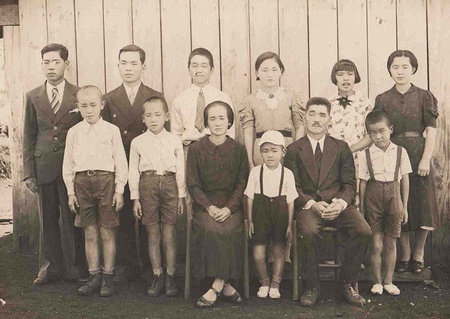Forty years ago, I went to Japan as a foreign exchange student.
At that time, my Japanese was limited to a few words. Yet, for whatever reason, I wasn’t worried at all. I think it was because I was young.
First, I found lodging and said to the woman who ran the place, “Please loan me a maekake.” She turned her head a bit and said, “If it’s an apron you want, here you go.”
After some time had passed, I went to Tokyo to visit my mom’s cousin. Since I was living in Niigata, she allowed me to spend the night. My mom’s cousin very generously said, “You must be tired. Why don’t you rest on the bed? I have some pajamas.” (Huh…not put on your nemaki [pajamas] and sleep in the nedoko [bed]?)
On the first day of class, the teacher told us to pull our notebooks, but what I had was called a chomen [notebook].
I knew “apron”, “bed”, “notebook”, and “pajamas” were English words, but I didn’t know they had become part of the Japanese language too.
My grandparents emigrated to Brazil in 1912, and all 10 of their children were born in Brazil. The language they spoke in the house was of course Japanese. One day my mom’s older brother said, “This is Brazil, so let’s speak Brazilian.” But no one could speak the language. So they just ended up having a good laugh.
My mother barely attended any Brazilian schools. So even though she was born in Brazil she’s more comfortable speaking Japanese, and she taught me hiragana and katakana.
When I visited Japan, I was shocked to learn that the Japanese I learned as a kid was outdated.
Because of that, I was naturally hesitant to have conversations with Japanese people. I didn’t want to embarass myself by using words people no longer used. One time when I couldn’t answer a question quickly, the people around felt sympathy for me, whispering “How sad...she doesn’t understand the language.”
Miniskirts were in fashion at that time. But I wasn’t one to follow the popular trends; I had my own style of clothing. So many people would ask me, “Aren’t miniskirts popular in Brazil?” It even made the local newspaper: “Brazilian Exchange Students Don’t Wear Minskirts!”
Back then, not much was known about Brazil. The migrant boom came much later, so the Brazilian presence was thin. The only image of the country seemed to be that of a “jungle”. That’s why a professor at Niigata University called me “Amazon-san”. That left me speechless and with mixed feelings. I didn’t know whether to laugh or cry.
Going back a little further, in the 1950s, a top Japanese male star went to Brazil. The Japanese community gave him a huge welcome. Female fans screamed and squealed. After his performance, that star told a reporter, “Japanese-Brazilian women are 100 years behind.” I was still just a kid so it didn’t really bother me, but my mom and the other Japanese-Brazilian women in the neighborhood were furious.
Since long ago, sports festivals have been held in Brazil as a type of traditional Japanese event. From the time I was a child, I heard sports festivals were held on “Tenchosetsu” (the Emperor’s birthday). But there’s something I’ve just recently noticed. While I was watching a Japanese TV show, I suddenly realized I didn’t hear the word tenchosetsu.
When I asked Japanese friends about it, they were surprised too.
The word tenchosetsu was used up until World War II. But with the war ended, from 1948 the name changed. I’m a member of the baby-boomer generation, but I can’t believe it took me this long to hear about that change.
© 2011 Laura Honda-Hasegawa





